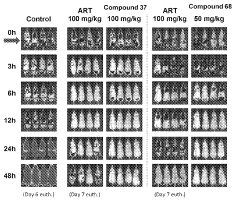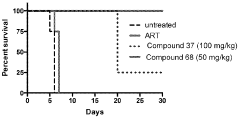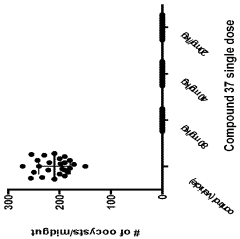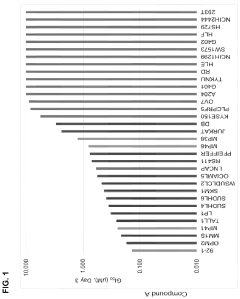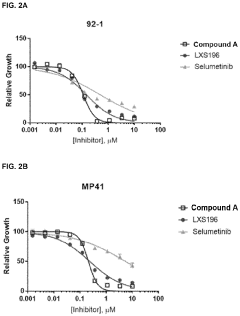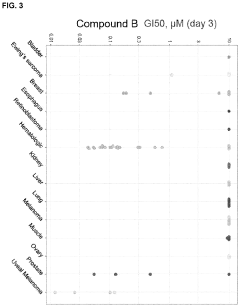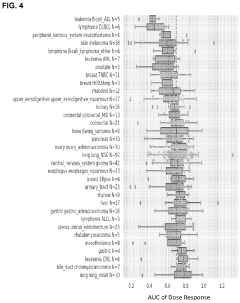Geometric Isomers and Their Effects on Lipid Membrane Interactions
AUG 1, 20259 MIN READ
Generate Your Research Report Instantly with AI Agent
Patsnap Eureka helps you evaluate technical feasibility & market potential.
Geometric Isomers Background and Research Objectives
Geometric isomers, a fundamental concept in organic chemistry, have gained significant attention in recent years due to their profound impact on lipid membrane interactions. These structural variants of molecules with identical molecular formulas but different spatial arrangements of atoms have been shown to exhibit diverse biological activities and physicochemical properties. The study of geometric isomers and their effects on lipid membranes has emerged as a critical area of research, bridging the gap between molecular structure and cellular function.
The historical context of geometric isomer research dates back to the early 20th century, with the discovery of cis-trans isomerism in organic compounds. However, it was not until the advent of advanced spectroscopic techniques and computational modeling that researchers could fully appreciate the intricate relationship between isomeric structures and their interactions with biological membranes. This technological progress has paved the way for a more comprehensive understanding of how subtle changes in molecular geometry can lead to significant alterations in membrane properties and cellular processes.
In recent years, the field has witnessed a surge of interest, driven by the potential applications in drug delivery, membrane biophysics, and the development of novel therapeutic strategies. The ability of geometric isomers to modulate membrane fluidity, permeability, and protein-lipid interactions has opened up new avenues for targeted drug design and the manipulation of cellular functions. Moreover, the study of geometric isomers has provided valuable insights into the molecular mechanisms underlying various physiological and pathological processes, including signal transduction, membrane fusion, and the action of certain toxins and antimicrobial agents.
The primary objectives of this research are multifaceted and ambitious. Firstly, we aim to elucidate the precise mechanisms by which geometric isomers interact with lipid membranes at the molecular level. This involves investigating how different isomeric forms influence membrane organization, dynamics, and phase behavior. Secondly, we seek to develop predictive models that can accurately forecast the impact of specific isomeric structures on membrane properties, potentially revolutionizing the field of rational drug design.
Furthermore, this research endeavors to explore the broader implications of geometric isomerism in biological systems, including its role in cellular homeostasis, drug resistance, and the development of novel biomaterials. By combining experimental approaches with advanced computational simulations, we aim to bridge the gap between molecular-level interactions and macroscopic membrane phenomena. Ultimately, this comprehensive study of geometric isomers and their effects on lipid membrane interactions promises to yield valuable insights that could transform our understanding of cellular biology and pave the way for innovative therapeutic strategies.
The historical context of geometric isomer research dates back to the early 20th century, with the discovery of cis-trans isomerism in organic compounds. However, it was not until the advent of advanced spectroscopic techniques and computational modeling that researchers could fully appreciate the intricate relationship between isomeric structures and their interactions with biological membranes. This technological progress has paved the way for a more comprehensive understanding of how subtle changes in molecular geometry can lead to significant alterations in membrane properties and cellular processes.
In recent years, the field has witnessed a surge of interest, driven by the potential applications in drug delivery, membrane biophysics, and the development of novel therapeutic strategies. The ability of geometric isomers to modulate membrane fluidity, permeability, and protein-lipid interactions has opened up new avenues for targeted drug design and the manipulation of cellular functions. Moreover, the study of geometric isomers has provided valuable insights into the molecular mechanisms underlying various physiological and pathological processes, including signal transduction, membrane fusion, and the action of certain toxins and antimicrobial agents.
The primary objectives of this research are multifaceted and ambitious. Firstly, we aim to elucidate the precise mechanisms by which geometric isomers interact with lipid membranes at the molecular level. This involves investigating how different isomeric forms influence membrane organization, dynamics, and phase behavior. Secondly, we seek to develop predictive models that can accurately forecast the impact of specific isomeric structures on membrane properties, potentially revolutionizing the field of rational drug design.
Furthermore, this research endeavors to explore the broader implications of geometric isomerism in biological systems, including its role in cellular homeostasis, drug resistance, and the development of novel biomaterials. By combining experimental approaches with advanced computational simulations, we aim to bridge the gap between molecular-level interactions and macroscopic membrane phenomena. Ultimately, this comprehensive study of geometric isomers and their effects on lipid membrane interactions promises to yield valuable insights that could transform our understanding of cellular biology and pave the way for innovative therapeutic strategies.
Market Applications of Geometric Isomers
Geometric isomers have found significant applications across various industries, leveraging their unique structural properties to enhance product performance and efficacy. In the pharmaceutical sector, these compounds play a crucial role in drug development and formulation. The spatial arrangement of atoms in geometric isomers can significantly influence a drug's interaction with biological targets, affecting its potency, bioavailability, and side effect profile. For instance, cis-platin, a geometric isomer of platinum complexes, has become a cornerstone in cancer chemotherapy due to its superior antitumor activity compared to its trans counterpart.
The cosmetics and personal care industry has also embraced geometric isomers, particularly in the development of skincare products. Retinoids, derivatives of vitamin A, exist in different geometric forms, with all-trans-retinoic acid being the most biologically active. These compounds are widely used in anti-aging formulations, acne treatments, and skin renewal products. The specific isomeric form can determine the compound's stability, skin penetration, and overall effectiveness in addressing various dermatological concerns.
In the field of materials science, geometric isomers have found applications in the development of advanced polymers and liquid crystals. The spatial configuration of these molecules can influence the physical properties of materials, such as their optical characteristics, thermal stability, and mechanical strength. This has led to innovations in display technologies, where specific geometric isomers of liquid crystal molecules are utilized to enhance the performance of LCD screens.
The agricultural sector has also benefited from the application of geometric isomers in pesticide and herbicide formulations. The spatial arrangement of atoms in these compounds can affect their interaction with target organisms, influencing factors such as toxicity, persistence in the environment, and selectivity. By carefully selecting the appropriate geometric isomer, agrochemical companies can develop more effective and environmentally friendly crop protection solutions.
In the food and flavor industry, geometric isomers play a role in creating and enhancing specific taste profiles. Certain flavor compounds exist in different geometric forms, each with distinct sensory properties. This knowledge has been leveraged to develop more nuanced and complex flavor profiles in food products, as well as in the creation of artificial flavoring agents that closely mimic natural compounds.
The emerging field of nanotechnology has also begun to explore the potential of geometric isomers in the design of nanomaterials and drug delivery systems. The spatial arrangement of molecules at the nanoscale can influence the self-assembly and properties of nanostructures, opening up new possibilities for targeted drug delivery, biosensors, and advanced materials with tailored functionalities.
The cosmetics and personal care industry has also embraced geometric isomers, particularly in the development of skincare products. Retinoids, derivatives of vitamin A, exist in different geometric forms, with all-trans-retinoic acid being the most biologically active. These compounds are widely used in anti-aging formulations, acne treatments, and skin renewal products. The specific isomeric form can determine the compound's stability, skin penetration, and overall effectiveness in addressing various dermatological concerns.
In the field of materials science, geometric isomers have found applications in the development of advanced polymers and liquid crystals. The spatial configuration of these molecules can influence the physical properties of materials, such as their optical characteristics, thermal stability, and mechanical strength. This has led to innovations in display technologies, where specific geometric isomers of liquid crystal molecules are utilized to enhance the performance of LCD screens.
The agricultural sector has also benefited from the application of geometric isomers in pesticide and herbicide formulations. The spatial arrangement of atoms in these compounds can affect their interaction with target organisms, influencing factors such as toxicity, persistence in the environment, and selectivity. By carefully selecting the appropriate geometric isomer, agrochemical companies can develop more effective and environmentally friendly crop protection solutions.
In the food and flavor industry, geometric isomers play a role in creating and enhancing specific taste profiles. Certain flavor compounds exist in different geometric forms, each with distinct sensory properties. This knowledge has been leveraged to develop more nuanced and complex flavor profiles in food products, as well as in the creation of artificial flavoring agents that closely mimic natural compounds.
The emerging field of nanotechnology has also begun to explore the potential of geometric isomers in the design of nanomaterials and drug delivery systems. The spatial arrangement of molecules at the nanoscale can influence the self-assembly and properties of nanostructures, opening up new possibilities for targeted drug delivery, biosensors, and advanced materials with tailored functionalities.
Current Challenges in Geometric Isomer Research
The field of geometric isomer research faces several significant challenges that hinder progress in understanding their effects on lipid membrane interactions. One of the primary obstacles is the complexity of synthesizing and isolating pure geometric isomers. The process often requires sophisticated techniques and can be time-consuming, making it difficult to obtain sufficient quantities of isomers for comprehensive studies.
Another challenge lies in the accurate characterization of geometric isomers. While techniques such as nuclear magnetic resonance (NMR) spectroscopy and X-ray crystallography can provide structural information, they may not always be suitable for all types of isomers or experimental conditions. This limitation can lead to uncertainties in the precise molecular configurations being studied.
The dynamic nature of lipid membranes presents additional complications in studying geometric isomer interactions. Membranes are fluid structures that constantly change, making it challenging to capture and analyze the precise moment and mechanism of isomer-membrane interactions. This fluidity also affects the reproducibility of experiments, as slight variations in membrane composition or environmental conditions can lead to significant differences in results.
Furthermore, the biological relevance of geometric isomers in lipid membrane interactions is not always clear. While laboratory studies can demonstrate certain effects, translating these findings to physiological conditions and understanding their implications in living systems remains a considerable challenge. This gap between in vitro observations and in vivo relevance often requires extensive validation and cross-disciplinary approaches.
The lack of standardized protocols for studying geometric isomer-membrane interactions also poses a significant hurdle. Different research groups may employ varying methodologies, making it difficult to compare results across studies and draw conclusive insights. This inconsistency hampers the development of a unified understanding of geometric isomer effects on lipid membranes.
Additionally, the molecular mechanisms underlying the interactions between geometric isomers and lipid membranes are not fully elucidated. While some general principles have been established, the specific factors that determine how different isomers interact with membranes, such as the role of molecular shape, polarity, and membrane composition, remain areas of active investigation.
Lastly, the development of computational models that accurately predict geometric isomer-membrane interactions is an ongoing challenge. While molecular dynamics simulations have provided valuable insights, they often struggle to capture the full complexity of these interactions, particularly over extended time scales relevant to biological processes.
Another challenge lies in the accurate characterization of geometric isomers. While techniques such as nuclear magnetic resonance (NMR) spectroscopy and X-ray crystallography can provide structural information, they may not always be suitable for all types of isomers or experimental conditions. This limitation can lead to uncertainties in the precise molecular configurations being studied.
The dynamic nature of lipid membranes presents additional complications in studying geometric isomer interactions. Membranes are fluid structures that constantly change, making it challenging to capture and analyze the precise moment and mechanism of isomer-membrane interactions. This fluidity also affects the reproducibility of experiments, as slight variations in membrane composition or environmental conditions can lead to significant differences in results.
Furthermore, the biological relevance of geometric isomers in lipid membrane interactions is not always clear. While laboratory studies can demonstrate certain effects, translating these findings to physiological conditions and understanding their implications in living systems remains a considerable challenge. This gap between in vitro observations and in vivo relevance often requires extensive validation and cross-disciplinary approaches.
The lack of standardized protocols for studying geometric isomer-membrane interactions also poses a significant hurdle. Different research groups may employ varying methodologies, making it difficult to compare results across studies and draw conclusive insights. This inconsistency hampers the development of a unified understanding of geometric isomer effects on lipid membranes.
Additionally, the molecular mechanisms underlying the interactions between geometric isomers and lipid membranes are not fully elucidated. While some general principles have been established, the specific factors that determine how different isomers interact with membranes, such as the role of molecular shape, polarity, and membrane composition, remain areas of active investigation.
Lastly, the development of computational models that accurately predict geometric isomer-membrane interactions is an ongoing challenge. While molecular dynamics simulations have provided valuable insights, they often struggle to capture the full complexity of these interactions, particularly over extended time scales relevant to biological processes.
Current Methodologies for Studying Lipid Membrane Interactions
01 Geometric isomers and lipid membrane structure
The geometric configuration of lipid molecules significantly influences the structure and properties of lipid membranes. Different isomers can affect membrane fluidity, thickness, and permeability. This interaction is crucial for understanding membrane dynamics and function in biological systems.- Geometric isomers and lipid membrane structure: The geometric configuration of lipid molecules significantly influences the structure and properties of lipid membranes. Different geometric isomers of lipids can affect membrane fluidity, thickness, and permeability. This interaction is crucial for understanding membrane function and designing drug delivery systems.
- Membrane-active peptides and geometric isomers: Geometric isomers of membrane-active peptides exhibit varying degrees of interaction with lipid membranes. The spatial arrangement of amino acids in these peptides can influence their ability to penetrate, disrupt, or stabilize lipid bilayers, which has implications for antimicrobial and cell-penetrating peptide design.
- Lipid isomerization and membrane properties: The isomerization of lipids within membranes can lead to changes in membrane properties. This process can be induced by various factors such as light, temperature, or chemical agents. Understanding these isomerization events is important for developing strategies to control membrane behavior in biotechnological applications.
- Geometric isomers in drug-membrane interactions: The geometric isomerism of drug molecules plays a crucial role in their interaction with lipid membranes. Different isomers may exhibit varying degrees of membrane permeability, affecting drug absorption and distribution. This knowledge is essential for optimizing drug formulations and predicting pharmacokinetic properties.
- Analytical techniques for studying isomer-membrane interactions: Various analytical techniques have been developed to study the interactions between geometric isomers and lipid membranes. These include spectroscopic methods, microscopy techniques, and computational simulations. These tools provide insights into the molecular-level details of isomer-membrane interactions, aiding in the design of novel membrane-interacting compounds.
02 Lipid isomer-based drug delivery systems
Geometric isomers of lipids are utilized in developing advanced drug delivery systems. The specific isomeric configuration can enhance drug encapsulation, control release rates, and improve targeting efficiency. This approach is particularly valuable for improving the efficacy of pharmaceutical formulations.Expand Specific Solutions03 Analytical methods for lipid isomer characterization
Advanced analytical techniques are employed to characterize geometric isomers of lipids and their interactions with membranes. These methods include spectroscopic techniques, chromatography, and microscopy, enabling detailed analysis of lipid-membrane dynamics and structural changes induced by different isomers.Expand Specific Solutions04 Isomer-specific effects on membrane proteins
The interaction between lipid geometric isomers and membrane proteins is a critical area of study. Different isomers can modulate protein function, stability, and conformational changes, impacting cellular processes and signaling pathways. This knowledge is essential for understanding protein-lipid interactions in biological membranes.Expand Specific Solutions05 Synthetic lipid isomers for membrane engineering
Researchers are developing synthetic lipid isomers with specific geometric configurations to engineer membranes with desired properties. These designer lipids can be used to create artificial membranes, liposomes, and other biomimetic systems with tailored characteristics for various applications in biotechnology and medicine.Expand Specific Solutions
Key Players in Geometric Isomer Research
The research on geometric isomers and their effects on lipid membrane interactions is in an early developmental stage, with a growing market potential as the importance of lipid-based drug delivery systems increases. The technology's maturity is still evolving, with key players like Yeda Research & Development, Genentech, and The Regents of the University of California leading academic and industrial research efforts. These organizations are exploring the fundamental science and potential applications, focusing on how geometric isomers can influence drug efficacy and cellular uptake. As the field progresses, we can expect increased collaboration between academic institutions and pharmaceutical companies to translate these findings into practical applications for drug delivery and membrane interaction optimization.
The Regents of the University of California
Technical Solution: The University of California has developed advanced techniques for studying geometric isomers and their interactions with lipid membranes. They utilize a combination of molecular dynamics simulations and experimental approaches, including fluorescence spectroscopy and atomic force microscopy, to investigate the effects of isomeric structures on membrane properties[1][3]. Their research focuses on how subtle changes in molecular geometry can significantly impact membrane fluidity, permeability, and protein-lipid interactions[2]. The university has also pioneered the use of novel lipid probes and advanced imaging techniques to visualize isomer-induced changes in membrane organization at the nanoscale level[4].
Strengths: Comprehensive approach combining computational and experimental methods; access to cutting-edge research facilities. Weaknesses: May face challenges in translating findings to practical applications in drug delivery or membrane engineering.
Genentech, Inc.
Technical Solution: Genentech has developed a proprietary platform for investigating the impact of geometric isomers on lipid membrane interactions, with a specific focus on enhancing drug delivery systems. Their approach involves synthesizing libraries of isomeric compounds and screening them for optimal membrane permeability and cellular uptake[5]. They employ high-throughput liposome-based assays to rapidly assess the effects of isomeric variations on membrane fusion and drug release kinetics[6]. Genentech has also integrated machine learning algorithms to predict isomer-membrane interactions, significantly accelerating the drug discovery process[7]. Their research has led to the development of several candidate molecules with improved pharmacokinetic profiles due to optimized lipid membrane interactions.
Strengths: Strong focus on practical applications in drug delivery; integration of AI for predictive modeling. Weaknesses: May be limited by the proprietary nature of their research, potentially restricting collaboration opportunities.
Breakthrough Findings in Geometric Isomer-Membrane Interactions
Compounds and methods for the treatment of malaria
PatentInactiveIN202118043692A
Innovation
- Development of specific compounds, such as those represented by Formula I and listed in Table 1, which offer new structural features and functional groups to target malaria parasites effectively, including those resistant to existing drugs.
Compounds and uses thereof
PatentPendingUS20230145003A1
Innovation
- Development of specific compounds that modulate the BAF complex by inhibiting BRG1 and/or BRM activity, which can be used alone or in combination with other pharmaceutically active agents to treat disorders like cancer.
Regulatory Considerations for Geometric Isomer Applications
The regulatory landscape for geometric isomer applications is complex and multifaceted, requiring careful consideration across various sectors. In the pharmaceutical industry, regulatory bodies such as the FDA and EMA have established stringent guidelines for the development and approval of drugs containing geometric isomers. These regulations often mandate the characterization and quantification of individual isomers, as well as the evaluation of their respective biological activities and safety profiles.
For food and agricultural applications, regulatory frameworks focus on the safety assessment of geometric isomers in food additives, pesticides, and genetically modified organisms. The Codex Alimentarius Commission, in collaboration with national food safety authorities, has developed standards for the use of geometric isomers in food products, emphasizing the importance of proper labeling and risk assessment.
In the cosmetics and personal care industry, regulations surrounding geometric isomers primarily concern their use as fragrances and active ingredients. The International Fragrance Association (IFRA) and the European Union's Cosmetic Regulation provide guidelines on the safe use of geometric isomers in cosmetic formulations, including maximum concentration limits and required safety assessments.
Environmental regulations also play a crucial role in geometric isomer applications, particularly in the context of their potential impact on ecosystems. Regulatory bodies such as the Environmental Protection Agency (EPA) in the United States and the European Chemicals Agency (ECHA) have established protocols for assessing the environmental fate and ecotoxicity of geometric isomers used in industrial processes and consumer products.
The regulatory landscape for geometric isomers is continually evolving, driven by advancements in analytical techniques and a growing understanding of their biological effects. Emerging areas of concern include the potential endocrine-disrupting properties of certain geometric isomers and their role in the development of antimicrobial resistance. As a result, regulatory bodies are increasingly adopting a precautionary approach, requiring more comprehensive safety data and risk assessments for geometric isomer applications.
Compliance with these diverse regulatory requirements presents significant challenges for industries utilizing geometric isomers. Companies must invest in robust analytical methods to accurately identify and quantify geometric isomers in their products, as well as conduct extensive toxicological and environmental impact studies. Additionally, the global nature of many industries necessitates compliance with multiple regulatory frameworks, adding complexity to product development and marketing strategies.
For food and agricultural applications, regulatory frameworks focus on the safety assessment of geometric isomers in food additives, pesticides, and genetically modified organisms. The Codex Alimentarius Commission, in collaboration with national food safety authorities, has developed standards for the use of geometric isomers in food products, emphasizing the importance of proper labeling and risk assessment.
In the cosmetics and personal care industry, regulations surrounding geometric isomers primarily concern their use as fragrances and active ingredients. The International Fragrance Association (IFRA) and the European Union's Cosmetic Regulation provide guidelines on the safe use of geometric isomers in cosmetic formulations, including maximum concentration limits and required safety assessments.
Environmental regulations also play a crucial role in geometric isomer applications, particularly in the context of their potential impact on ecosystems. Regulatory bodies such as the Environmental Protection Agency (EPA) in the United States and the European Chemicals Agency (ECHA) have established protocols for assessing the environmental fate and ecotoxicity of geometric isomers used in industrial processes and consumer products.
The regulatory landscape for geometric isomers is continually evolving, driven by advancements in analytical techniques and a growing understanding of their biological effects. Emerging areas of concern include the potential endocrine-disrupting properties of certain geometric isomers and their role in the development of antimicrobial resistance. As a result, regulatory bodies are increasingly adopting a precautionary approach, requiring more comprehensive safety data and risk assessments for geometric isomer applications.
Compliance with these diverse regulatory requirements presents significant challenges for industries utilizing geometric isomers. Companies must invest in robust analytical methods to accurately identify and quantify geometric isomers in their products, as well as conduct extensive toxicological and environmental impact studies. Additionally, the global nature of many industries necessitates compliance with multiple regulatory frameworks, adding complexity to product development and marketing strategies.
Environmental Impact of Geometric Isomers
The environmental impact of geometric isomers in lipid membrane interactions is a critical aspect of research that extends beyond laboratory settings. These isomers, which have the same molecular formula but different spatial arrangements, can significantly influence ecosystem dynamics and environmental health.
Geometric isomers of lipids can affect the permeability and fluidity of cell membranes in various organisms, from microorganisms to plants and animals. This alteration in membrane properties can lead to changes in cellular function, potentially impacting entire ecosystems. For instance, in aquatic environments, the presence of certain geometric isomers may affect the ability of phytoplankton to regulate their buoyancy, influencing their distribution in the water column and, consequently, the entire food web.
The persistence of geometric isomers in the environment is another crucial factor to consider. Some isomers may be more resistant to degradation, leading to bioaccumulation in organisms and biomagnification through trophic levels. This can result in long-term ecological consequences, particularly in apex predators and species with longer lifespans.
Furthermore, the interaction between geometric isomers and lipid membranes can affect the toxicity and bioavailability of various pollutants. Certain isomers may enhance the uptake of environmental contaminants by organisms, potentially exacerbating the impact of pollution on ecosystems. Conversely, some isomers might act as natural barriers, reducing the absorption of harmful substances.
The environmental fate of geometric isomers is also influenced by abiotic factors such as temperature, pH, and UV radiation. These factors can induce isomerization processes, potentially altering the environmental distribution and effects of these compounds. Climate change may further complicate this dynamic, as shifting environmental conditions could modify the behavior and impact of geometric isomers in ecosystems.
In agricultural settings, the presence of specific geometric isomers in soil can affect plant growth and crop yields. These isomers may influence root membrane permeability, nutrient uptake, and plant-microbe interactions in the rhizosphere. Understanding these effects is crucial for sustainable agriculture practices and maintaining soil health.
Lastly, the potential for geometric isomers to act as endocrine disruptors in wildlife populations is an emerging concern. Alterations in hormone signaling pathways due to interactions with lipid membranes could lead to reproductive issues, developmental abnormalities, and population-level effects in various species.
Geometric isomers of lipids can affect the permeability and fluidity of cell membranes in various organisms, from microorganisms to plants and animals. This alteration in membrane properties can lead to changes in cellular function, potentially impacting entire ecosystems. For instance, in aquatic environments, the presence of certain geometric isomers may affect the ability of phytoplankton to regulate their buoyancy, influencing their distribution in the water column and, consequently, the entire food web.
The persistence of geometric isomers in the environment is another crucial factor to consider. Some isomers may be more resistant to degradation, leading to bioaccumulation in organisms and biomagnification through trophic levels. This can result in long-term ecological consequences, particularly in apex predators and species with longer lifespans.
Furthermore, the interaction between geometric isomers and lipid membranes can affect the toxicity and bioavailability of various pollutants. Certain isomers may enhance the uptake of environmental contaminants by organisms, potentially exacerbating the impact of pollution on ecosystems. Conversely, some isomers might act as natural barriers, reducing the absorption of harmful substances.
The environmental fate of geometric isomers is also influenced by abiotic factors such as temperature, pH, and UV radiation. These factors can induce isomerization processes, potentially altering the environmental distribution and effects of these compounds. Climate change may further complicate this dynamic, as shifting environmental conditions could modify the behavior and impact of geometric isomers in ecosystems.
In agricultural settings, the presence of specific geometric isomers in soil can affect plant growth and crop yields. These isomers may influence root membrane permeability, nutrient uptake, and plant-microbe interactions in the rhizosphere. Understanding these effects is crucial for sustainable agriculture practices and maintaining soil health.
Lastly, the potential for geometric isomers to act as endocrine disruptors in wildlife populations is an emerging concern. Alterations in hormone signaling pathways due to interactions with lipid membranes could lead to reproductive issues, developmental abnormalities, and population-level effects in various species.
Unlock deeper insights with Patsnap Eureka Quick Research — get a full tech report to explore trends and direct your research. Try now!
Generate Your Research Report Instantly with AI Agent
Supercharge your innovation with Patsnap Eureka AI Agent Platform!
